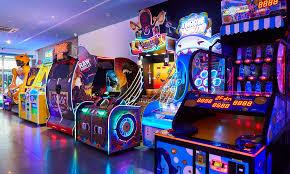The Timeless Appeal of the Arcade Game: From Retro Fun to Digital Evolution

Introduction
Arcade games are more than just machines with blinking lights and beeping sounds—they are cultural time capsules. From the early 1970s to the modern day, the arcade game has captivated millions, providing entertainment, competition, and nostalgia across generations. Whether it’s the clinking of tokens or the challenge of beating a high score, arcade games have carved a special place in gaming history.
The Birth of the Arcade Era
The first significant wave of arcade games emerged in the early 1970s, led by games like Pong by Atari. Simple in design yet addictive in gameplay, Pong marked the dawn of a new entertainment medium. Soon, the late '70s and early '80s became the golden age of arcade gaming, introducing classics such as Space Invaders, Pac-Man, Donkey Kong, and Galaga. These games were often found in shopping malls, movie theaters, and dedicated arcades, becoming a social hub for young people.
What made these early games revolutionary was their pick-up-and-play nature. Players didn’t need instruction manuals—just a few coins and the desire to beat the high score.
Cultural Impact and the Rise of Competitive Play
More than just providing amusement, arcade games gave rise to a whole subculture.. Leaderboards encouraged competition, and local legends were made based on who could get the highest score. Some players even gained national fame. For example, Billy Mitchell became world-renowned for his high scores in Pac-Man and Donkey Kong, showing how arcade gaming could elevate a person’s status in the gaming community.
Arcades were also social places. Friends gathered, cheered each other on, and challenged strangers. The arcade game was at the heart of a budding gaming community before the internet made online multiplayer possible.
The Decline and Transformation of Arcades
By the late 1990s, arcade games began to lose their dominance due to the rise of home gaming consoles like PlayStation and Xbox. These consoles provided high-quality graphics and multiplayer experiences in the comfort of one's living room. As technology advanced, many traditional arcades closed down, and the arcade game seemed to fade into obscurity.
However, this wasn’t the end. Instead, arcades began to evolve. The focus shifted from pixelated screens to immersive experiences that home consoles couldn't replicate. Games like Dance Dance Revolution, Time Crisis, and driving simulators brought players back for experiences that needed physical setups and social interaction.
The Retro Revival: Nostalgia Brings Arcade Games Back
In recent years, nostalgia has triggered a renaissance in arcade gaming. Retro bars and gaming cafes have popped up worldwide, offering classic arcade game experiences with a modern twist. These venues attract both older players reminiscing about their youth and younger audiences discovering the charm of games that don’t rely on high-end graphics but on fun, skill, and simplicity.
Little arcade machines and plug-and-play consoles have also gained popularity, enabling individuals to experience their favorite childhood games at home. This revival proves the lasting charm of arcade gaming and its ability to transcend generations.
Modern Innovations in Arcade Gaming
Today’s arcade games have embraced technology in innovative ways. Virtual reality (VR) and augmented reality (AR) have created fully immersive experiences, blurring the lines between digital and physical play. Games like Beat Saber and VR racing simulators are taking the arcade experience to new heights.
Moreover, mobile integration and online connectivity have allowed modern arcade machines to update scores in real-time, host tournaments, and even reward players digitally. These innovations keep the arcade game relevant in an age where digital interaction dominates.
See more related new york style pizza near me
Why Arcade Games Still Matter
Despite technological advances, the arcade game still holds a unique space in the world of entertainment. It represents an era of pure, skill-based fun, where the only goal was to beat your best—or someone else’s best. There are no in-game purchases, no complex storylines—just you, the game, and the challenge.
In addition, arcade games are inclusive. Whether you're 7 or 70, the barrier to entry is low, making it a perfect bonding activity across age groups. This accessibility keeps arcades alive, even in a world filled with smartphones and high-powered gaming rigs.
The Future of Arcade Gaming
The future of arcade gaming lies in hybrid experiences that combine physical environments with digital play. Interactive projection games, touch-based walls, and escape room-style arcade experiences are reshaping what arcade games can be. Esports arenas and VR arcades are also creating new ways for players to engage socially and competitively.
As technology continues to evolve, the spirit of arcade games will persist—not necessarily in their original form, but in the values they represent: challenge, community, and creativity.
Conclusion: A Legacy That Lives On
There is more to the arcade game than just nostalgia.It's a living, evolving form of entertainment that adapts to each generation’s tastes while preserving the excitement and simplicity that made it great. Whether through a vintage Pac-Man machine or a state-of-the-art VR arena, arcade games continue to capture the hearts of players around the world.
Check new article click here
- Art
- Causes
- Crafts
- Dance
- Drinks
- Film
- Fitness
- Food
- Spiele
- Gardening
- Health
- Home
- Literature
- Music
- Networking
- Other
- Party
- Religion
- Shopping
- Sports
- Theater
- Wellness
- Script
- App
